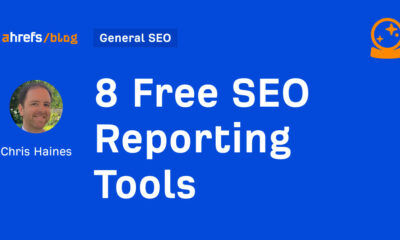MARKETING
20 of the Best Free Google Sheets Templates for 2022

Google Sheets templates help you create better spreadsheets while saving you valuable time.
A template knows what you need and offers it without any manual input, giving you the ability to focus on more important things — such as making sense of the data itself.
In this post, we’ll cover every template you’ll ever need to easily and efficiently use Google Sheets for business, including templates for project management, reporting, people management, and customer tracking.
You’ll learn:
1. Why you should use Google Sheets templates for business;
2. Step-by-step instruction on how to find the built-in Google Sheets templates;
3. A roundup of additional Google Sheets templates for any marketing role, including:
Let’s get started.
Why use Google Sheets templates for business?
Google Sheets templates are a fantastic business tool that can be used by teams of any size. Whether you’re a business just starting out or an established enterprise firm, you’ll enjoy countless benefits when using Google Sheets templates.
Even if you don’t use them as your primary business tool, they can supplement other tools. For instance, you might use a free CRM to track customer information, then use a Google Sheets invoice template to quickly create invoices for each customer.
Let’s go over the top benefits of using Google Sheets templates for business.
Free
Google Sheets templates are completely free to use, and they cover a wide variety of needs. So you won’t have to spend hundreds of thousands of dollars getting an Excel subscription (or a subscription for another tool). Simply have everyone sign up for a Google Workspace account and get immediate working access to the templates.
Ability to Collaborate
Google Sheets templates allow your team to collaborate with little gatekeeping. The only thing you have to do is click the “Share” button at the top right-hand corner of a document, and your team members will have access to the file.
You can also limit the collaboration aspect to commenting or viewing only. This is a great option for sensitive documents that only a few people should edit.
Intuitive to Use
To use a Google Sheets template, you need very little experience with spreadsheets. You don’t need to know advanced formulas and functions to make them work for you. The templates already come with all of the fields and calculations built-in. All you have to do is plug in the numbers and populate the fields, and the document will generate a report or calculate a total.
Customizable
That you’re using a template doesn’t mean that you’re stuck with its look and feel. You can easily change the fields, the colors, and the fonts using Google Sheets’ built-in tools. Once you do, you’ll feel like the template is your business’ only.
No Data Loss
Another great benefit of using Google Sheets templates? Unless a freak accident happens with Google’s servers, it’s near impossible to lose data. All changes are stored in the cloud, and Google Sheets includes a version history of the document, where you can revert to a previous version if something happens.
If your laptop crashes or you lose internet connection, Google Sheets simply freezes the copy until you’re online again. You’ll still want to take a few precautions, such as enabling offline editing and downloading a copy of the document to your local drive.
Ready to find a few templates that you can start using right now for your business?
How to Find Templates In Google Sheets
There are two common ways you can find and use free Google Sheets templates.
1. Google’s In-Built Template Gallery
On your browser, go to Google Sheets. Click “Template Gallery” at the top right. Explore the templates to find the right one for you.
You’ll find different templates for your personal, work, and project management needs. Here’s an example of what the Personal template library looks like:
2. Add-Ons
Another way to find free templates in Google Sheets is to download and install the Vertex42 add-on. Here’s how:
Open an existing Google sheet, or type “sheets.new” to create a new one. Then, find and click the “Add-ons” button on the top left menu.
Type “Vertex42” into the search bar, and click enter. Install the add-on.
To access the templates, click on “Add-ons,” then “Template Gallery for Sheets,” then “Browse Templates.”
Here you would find templates that can help with almost everything you need — whether you need to create an invoice, income/expense tracker, or a dashboard to manage your projects.
Let’s now look at some of the free Google Sheets templates you would find useful as you run your business.
Google Sheets Templates
Whether your position requires you to send invoices to clients, track website analytics, or create budget and expense reports, you’ve undoubtedly found yourself working with spreadsheets in some form. And if you’re anything like me, those spreadsheets can feel frustratingly tedious when you’re under a time crunch.
Fortunately, Google Sheets offers a wide variety of pre-built templates, allowing you to create reports and analyze data in spreadsheets faster and more effectively.
The following Google Sheets templates cater to specific categories and allow you to cut hours, if not days, of work in one fell swoop. Let’s go over the best google Sheets templates you can start using now.
Google Sheets Templates for Finances
Spreadsheets are popular tool for bookkeeping and invoicing. Below, you’ll find a curated selection of ready-to-go templates that will allow you to invoice clients, maintain an annual business budget, generate financial statements, create expense reports, and generate purchase reports.
The result is a ton of saved time — there’s no need to create or choose any formulas that will help you calculate this data.
1. Invoices
If you’re a freelancer or work for a small business, you probably use invoices to bill clients for services. This invoice template makes the process simple — it provides space for all the necessary information and looks more professional than a plain spreadsheet. Plus, the template is customizable, so you can create a theme that aligns well with your brand image.
Click here to use this template.
2. Annual Business Budget
This template is more in-depth than it initially appears. There are tabs at the bottom — setup, income, expenses, summary — and each one includes several subcategories. “Expenses,” for instance, covers everything from taxes and insurance to travel and customer acquisition.
The final tab, “summary,” takes your income, subtracts your expenses, and automatically updates to display your ending balance each month. This template is a good option if your budget requires a lot of customization and many moving parts.
Click here to use this template.
3. Financial Statements
The financial statements template truly is an all-in-one resource to keep track of business transactions, profits, and losses. The “profit & loss” tab automatically summarizes revenue, costs, and expenses for the year and can display your growth rate percentage.
If you work for a small business and need to manage much of your finances, this template offers resources and guidance to make the process easier and less prone to human error.
Click here to use this template.
4. Expense Report
Knowing how much you spend is an essential part of running a successful business. But it’s often easy to forget to record these expenses with the amount of work you have to do every day. This simple expense report template makes it easy to record all of your expenses and those of your employees.
Click here to use this template.
5. Purchase Order
You’ll find this template to be a life-saver if tracking the orders or supplies your office/department makes is part of your job. With this sheet, you can save time and avoid the headaches that come with monitoring orders or shipments.
Click here to use this template.
Google Sheet Templates for Reporting and Analytics
Reporting dashboards are typically built into a wide variety of software products, such as Marketing Hub, but if you don’t have the budget, you can easily create one using a Google Sheets template.
The below templates automatically gather data from Google Analytics, putting the data in a highly digestible visual format that you can share with higher-ups and other people in your team.
6. Website Traffic Dashboard
Suppose your role requires you to analyze website traffic using Google Analytics. In that case, this template is a fantastic supplemental tool to pull that data into an organized report, saving you tons of time. Better still, you can use the dashboard template with Supermetrics Google Sheets add-on to monitor and analyze data from PPC, SEO, social media, and website analytics.
Click here to use this template.
7. Website Paid Traffic Report
This template makes the process of analyzing and reporting on paid traffic relatively seamless. The spreadsheet is split into Overview, 12-month Trends, and Medium Breakdown categories. It automatically collects data on your paid sources from Google Analytics and provides a clean chart with important information, including PPC’s percentage of goal conversions, total traffic, and bounce rate.
You can also adjust it to compare different periods or different channels or segments. If you’re looking for a way to demonstrate paid’s influence on your business, this is the tool to do it.
Click here to use this template.
Google Sheet Templates for Customers
If you don’t have access to a CRM yet or your business is still growing, you can use spreadsheets to track customer information and see the growth of your business. The below Google Sheets templates allow you to have a CRM and a sales dashboard without paying the cost typically needed for such software.
Remember, however, that as your business starts to grow and you earn more and more customers, you’ll want to switch over to a dedicated CRM.
8. CRM
To organize your contacts and automate an effective sales and marketing process, you must have a CRM — but if you’re a small company just starting, you might not feel ready to implement a fully established CRM with all the features.
This CRM template is a great place to get your feet wet. It saves automatically, so you never lose data. The share feature allows you to work with coworkers within the CRM, which helps encourage collaboration between your sales and marketing departments.
Click here to use this template.
9. Sales Dashboard
This template helps salespeople manage their leads, sales, and revenue all in one place. At the bottom of the template are different tabs where you can easily input your data that eventually shows up on the main dashboard. There’s also an “instructions” tab to get you up to speed with using the sheet.
Click here to use this template.
Google Sheet Templates for Project Management
Using a Google Sheets project management template is a much more cost-effective alternative to buying a team-wide subscription for a project management software.
The below templates are the absolute best for keeping track of a project’s timeline, creating Gantt charts, creating product roadmaps, and generating action lists. They allow you to color-code and categorize action items and individual tasks.
Hot tip: If you’re managing multiple projects, simply duplicate the initial tab and keep all projects in a single spreadsheet.
10. Project Timeline
Whether this is your first significant project or you’ve been managing projects for years, the project timeline template is a valuable tool for organizing and implementing each project step. The template helps you visually break up a daunting project into smaller pieces, ideally making it easier and less stressful to manage and delegate tasks.
Click here to use this template.
11. Project Tracking
If you’re juggling many projects simultaneously, this project tracking template could become your new best friend. This template takes project management to the next level by enabling you to organize your tasks into categories by date, deliverables, status, cost, and hours — best of all, it lets you prioritize your projects. Hopefully, simply visualizing what needs to get done first will alleviate time-management stress.
Click here to use this template.
12. Event Marketing Timeline
The event marketing template offers organization and structure if you’re implementing an upcoming business event or campaign. It provides categories you might’ve forgotten to consider, including local and national marketing, PR, and web, with subcategories ranging from an email newsletter to impact studies.
The template is already organized with all necessary categories for planning an event, reducing the time you spend on tedious manual input.
Click here to use this template.
13. Gantt Chart Template
The Gantt chart template helps you alleviate any concern you might have over timing — and, when you’ve got a complex project with overlapping components, I’m willing to bet timing is one of your primary concerns.
Using the Gantt chart template helps you visualize all steps and delegate essential tasks more efficiently — labeling the task with an owner on one chart is undoubtedly easier than individually following up via email. And by sharing the template with coworkers, everyone is on the same page.
Click here to use this template.
14. Product Roadmap
Without a product roadmap, it’s easy for your team to misunderstand the direction you want a project to take. With this template, you can solve that problem. The template provides a calendar summary of a project and the milestones and deliverables as you go through the product development process.
Click here to use this template.
15. Product Launch Plan
This template has everything you need to organize the best product launch you’ve ever had. It has fields to help you outline your market and competitive analysis, project strategy, key messaging, and who your target audience is.
If you’re in charge of managing a product launch and want to organize the best launch ever, then this is the project management template for you.
Click here to use this template.
16. Action List With Ranking
Managing a project requires that you track daily actions to ensure you don’t lose focus. But sometimes, you’ll have some tasks on your list that are more important than others. You can easily arrange these tasks based on their importance with this action list template. You can also share this sheet with others if you’re working as a team.
Click here to use this template.
17. Project Budget
Away from the general business budget, most managers create budgets for each of their projects. This project budget template is for you if you’re looking for a simple yet effective template that lets you quickly estimate how much revenue a project would generate and how much it would cost.
Click here to use this template.
Google Sheet Templates for Leading a Team
Managing a team is easy and simple with the following Google Sheets templates. No need to send emails back and forth, and no need to check in individually with each team member over Slack or another team communication app.
With the following templates, you can set employee shifts and track how many hours employees have spent on a certain project. And remember, these templates are collaborative — meaning that you only need to give access to your employees for them to fill it out on their own time. The changes will immediately be live in the shared copy.
18. Employee Shift Schedule
Keeping track of who works what hours, and how much each employee gets paid, can feel confusing, especially if you lead a team of part-time contractors or seasonal interns. This template includes slots for employee’s names, hours worked, and monthly wages, making your paycheck process straightforward and organized.
Click here to use this template.
19. Weekly Timesheet
Like the employee shift schedule, the weekly timesheet helps you track time and know how much to pay employees or subcontractors. However, the weekly timesheet template works better if you want to quickly find out how much time each employee spends on a project.
Click here to use this template.
20. Contact List
This template comes in handy if you want to create a contact list database. You can easily use the template to store your contact information (say, phone number and email address), your employees’ contact, and those of emergency services like the ambulance or fire department.
Click here to use this template.
Start Using These Free Google Sheets Templates
No matter what your job is, using a suitable spreadsheet would make it easier and more enjoyable.
So what are you waiting for? Get started with using these free Google Sheets templates to save time and effort, and download ten additional ones to exponentially improve your productivity.
Editor’s note: This post was originally published in January 2018 and has been updated for comprehensiveness.
Source link
MARKETING
Will Google Buy HubSpot? | Content Marketing Institute

Google + HubSpot. Is it a thing?
This week, a flurry of news came down about Google’s consideration of purchasing HubSpot.
The prospect dismayed some. It delighted others.
But is it likely? Is it even possible? What would it mean for marketers? What does the consideration even mean for marketers?
Well, we asked CMI’s chief strategy advisor, Robert Rose, for his take. Watch this video or read on:
Why Alphabet may want HubSpot
Alphabet, the parent company of Google, apparently is contemplating the acquisition of inbound marketing giant HubSpot.
The potential price could be in the range of $30 billion to $40 billion. That would make Alphabet’s largest acquisition by far. The current deal holding that title happened in 2011 when it acquired Motorola Mobility for more than $12 billion. It later sold it to Lenovo for less than $3 billion.
If the HubSpot deal happens, it would not be in character with what the classic evil villain has been doing for the past 20 years.
At first glance, you might think the deal would make no sense. Why would Google want to spend three times as much as it’s ever spent to get into the inbound marketing — the CRM and marketing automation business?
At a second glance, it makes a ton of sense.
I don’t know if you’ve noticed, but I and others at CMI spend a lot of time discussing privacy, owned media, and the deprecation of the third-party cookie. I just talked about it two weeks ago. It’s really happening.
All that oxygen being sucked out of the ad tech space presents a compelling case that Alphabet should diversify from third-party data and classic surveillance-based marketing.
Yes, this potential acquisition is about data. HubSpot would give Alphabet the keys to the kingdom of 205,000 business customers — and their customers’ data that almost certainly numbers in the tens of millions. Alphabet would also gain access to the content, marketing, and sales information those customers consumed.
Conversely, the deal would provide an immediate tip of the spear for HubSpot clients to create more targeted programs in the Alphabet ecosystem and upload their data to drive even more personalized experiences on their own properties and connect them to the Google Workspace infrastructure.
When you add in the idea of Gemini, you can start to see how Google might monetize its generative AI tool beyond figuring out how to use it on ads on search results pages.
What acquisition could mean for HubSpot customers
I may be stretching here but imagine this world. As a Hubspoogle customer, you can access an interface that prioritizes your owned media data (e.g., your website, your e-commerce catalog, blog) when Google’s Gemini answers a question).
Recent reports also say Google may put up a paywall around the new premium features of its artificial intelligence-powered Search Generative Experience. Imagine this as the new gating for marketing. In other words, users can subscribe to Google’s AI for free, but Hubspoogle customers can access that data and use it to create targeted offers.
The acquisition of HubSpot would immediately make Google Workspace a more robust competitor to Microsoft 365 Office for small- and medium-sized businesses as they would receive the ADDED capability of inbound marketing.
But in the world of rented land where Google is the landlord, the government will take notice of the acquisition. But — and it’s a big but, I cannot lie (yes, I just did that). The big but is whether this acquisition dance can happen without going afoul of regulatory issues.
Some analysts say it should be no problem. Others say, “Yeah, it wouldn’t go.” Either way, would anybody touch it in an election year? That’s a whole other story.
What marketers should realize
So, what’s my takeaway?
It’s a remote chance that Google will jump on this hard, but stranger things have happened. It would be an exciting disruption in the market.
The sure bet is this. The acquisition conversation — as if you needed more data points — says getting good at owned media to attract and build audiences and using that first-party data to provide better communication and collaboration with your customers are a must.
It’s just a matter of time until Google makes a move. They might just be testing the waters now, but they will move here. But no matter what they do, if you have your customer data house in order, you’ll be primed for success.
HANDPICKED RELATED CONTENT:
Cover image by Joseph Kalinowski/Content Marketing Institute
MARKETING
5 Psychological Tactics to Write Better Emails

Welcome to Creator Columns, where we bring expert HubSpot Creator voices to the Blogs that inspire and help you grow better.
I’ve tested 100s of psychological tactics on my email subscribers. In this blog, I reveal the five tactics that actually work.
You’ll learn about the email tactic that got one marketer a job at the White House.
You’ll learn how I doubled my 5 star reviews with one email, and why one strange email from Barack Obama broke all records for donations.
5 Psychological Tactics to Write Better Emails
Imagine writing an email that’s so effective it lands you a job at the White House.
Well, that’s what happened to Maya Shankar, a PhD cognitive neuroscientist. In 2014, the Department of Veterans Affairs asked her to help increase signups in their veteran benefit scheme.
Maya had a plan. She was well aware of a cognitive bias that affects us all—the endowment effect. This bias suggests that people value items higher if they own them. So, she changed the subject line in the Veterans’ enrollment email.
Previously it read:
- Veterans, you’re eligible for the benefit program. Sign up today.
She tweaked one word, changing it to:
- Veterans, you’ve earned the benefits program. Sign up today.
This tiny tweak had a big impact. The amount of veterans enrolling in the program went up by 9%. And Maya landed a job working at the White House

Inspired by these psychological tweaks to emails, I started to run my own tests.
Alongside my podcast Nudge, I’ve run 100s of email tests on my 1,000s of newsletter subscribers.
Here are the five best tactics I’ve uncovered.
1. Show readers what they’re missing.
Nobel prize winning behavioral scientists Daniel Kahneman and Amos Tversky uncovered a principle called loss aversion.
Loss aversion means that losses feel more painful than equivalent gains. In real-world terms, losing $10 feels worse than how gaining $10 feels good. And I wondered if this simple nudge could help increase the number of my podcast listeners.
For my test, I tweaked the subject line of the email announcing an episode. The control read:
“Listen to this one”
In the loss aversion variant it read:
“Don’t miss this one”
It is very subtle loss aversion. Rather than asking someone to listen, I’m saying they shouldn’t miss out. And it worked. It increased the open rate by 13.3% and the click rate by 12.5%. Plus, it was a small change that cost me nothing at all.

2. People follow the crowd.
In general, humans like to follow the masses. When picking a dish, we’ll often opt for the most popular. When choosing a movie to watch, we tend to pick the box office hit. It’s a well-known psychological bias called social proof.
I’ve always wondered if it works for emails. So, I set up an A/B experiment with two subject lines. Both promoted my show, but one contained social proof.
The control read: New Nudge: Why Brands Should Flaunt Their Flaws
The social proof variant read: New Nudge: Why Brands Should Flaunt Their Flaws (100,000 Downloads)
I hoped that by highlighting the episode’s high number of downloads, I’d encourage more people to listen. Fortunately, it worked.
The open rate went from 22% to 28% for the social proof version, and the click rate, (the number of people actually listening to the episode), doubled.
3. Praise loyal subscribers.
The consistency principle suggests that people are likely to stick to behaviours they’ve previously taken. A retired taxi driver won’t swap his car for a bike. A hairdresser won’t change to a cheap shampoo. We like to stay consistent with our past behaviors.
I decided to test this in an email.
For my test, I attempted to encourage my subscribers to leave a review for my podcast. I sent emails to 400 subscribers who had been following the show for a year.
The control read: “Could you leave a review for Nudge?”
The consistency variant read: “You’ve been following Nudge for 12 months, could you leave a review?”
My hypothesis was simple. If I remind people that they’ve consistently supported the show they’ll be more likely to leave a review.
It worked.
The open rate on the consistency version of the email was 7% higher.
But more importantly, the click rate, (the number of people who actually left a review), was almost 2x higher for the consistency version. Merely telling people they’d been a fan for a while doubled my reviews.
4. Showcase scarcity.
We prefer scarce resources. Taylor Swift gigs sell out in seconds not just because she’s popular, but because her tickets are hard to come by.
Swifties aren’t the first to experience this. Back in 1975, three researchers proved how powerful scarcity is. For the study, the researchers occupied a cafe. On alternating weeks they’d make one small change in the cafe.
On some weeks they’d ensure the cookie jar was full.
On other weeks they’d ensure the cookie jar only contained two cookies (never more or less).
In other words, sometimes the cookies looked abundantly available. Sometimes they looked like they were almost out.
This changed behaviour. Customers who saw the two cookie jar bought 43% more cookies than those who saw the full jar.
It sounds too good to be true, so I tested it for myself.
I sent an email to 260 subscribers offering free access to my Science of Marketing course for one day only.
In the control, the subject line read: “Free access to the Science of Marketing course”
For the scarcity variant it read: “Only Today: Get free access to the Science of Marketing Course | Only one enrol per person.”
130 people received the first email, 130 received the second. And the result was almost as good as the cookie finding. The scarcity version had a 15.1% higher open rate.

5. Spark curiosity.
All of the email tips I’ve shared have only been tested on my relatively small audience. So, I thought I’d end with a tip that was tested on the masses.
Back in 2012, Barack Obama and his campaign team sent hundreds of emails to raise funds for his campaign.
Of the $690 million he raised, most came from direct email appeals. But there was one email, according to ABC news, that was far more effective than the rest. And it was an odd one.
The email that drew in the most cash, had a strange subject line. It simply said “Hey.”
The actual email asked the reader to donate, sharing all the expected reasons, but the subject line was different.
It sparked curiosity, it got people wondering, is Obama saying Hey just to me?
Readers were curious and couldn’t help but open the email. According to ABC it was “the most effective pitch of all.”
Because more people opened, it raised more money than any other email. The bias Obama used here is the curiosity gap. We’re more likely to act on something when our curiosity is piqued.

Loss aversion, social proof, consistency, scarcity and curiosity—all these nudges have helped me improve my emails. And I reckon they’ll work for you.
It’s not guaranteed of course. Many might fail. But running some simple a/b tests for your emails is cost free, so why not try it out?
This blog is part of Phill Agnew’s Marketing Cheat Sheet series where he reveals the scientifically proven tips to help you improve your marketing. To learn more, listen to his podcast Nudge, a proud member of the Hubspot Podcast Network.
MARKETING
The power of program management in martech

As a supporter of the program perspective for initiatives, I recognize the value of managing related projects, products and activities as a unified entity.
While one-off projects have their place, they often involve numerous moving parts and in my experience, using a project-based approach can lead to crucial elements being overlooked. This is particularly true when building a martech stack or developing content, for example, where a program-based approach can ensure that all aspects are considered and properly integrated.
For many CMOs and marketing organizations, programs are becoming powerful tools for aligning diverse initiatives and driving strategic objectives. Let’s explore the essential role of programs in product management, project management and marketing operations, bridging technical details with business priorities.
Programs in product management
Product management is a fascinating domain where programs operate as a strategic framework, coordinating related products or product lines to meet specific business objectives.
Product managers are responsible for defining a product or product line’s strategy, roadmap and features. They work closely with program managers, who ensure alignment with market demands, customer needs and the company’s overall vision by managing offerings at a program level.
Program managers optimize the product portfolio, make strategic decisions about resource allocation and ensure that each product contributes to the program’s goals. One key aspect of program management in product management is identifying synergies between products.
Program managers can drive innovation and efficiency across the portfolio by leveraging shared technologies, customer insights, or market trends. This approach enables organizations to respond quickly to changing market conditions, seize emerging opportunities and maintain a competitive advantage. Product managers, in turn, use these insights to shape the direction of individual products.
Moreover, programs in product management facilitate cross-functional collaboration and knowledge sharing. Program managers foster a holistic understanding of customer needs and market dynamics by bringing together teams from various departments, such as engineering, marketing and sales.
Product managers also play a crucial role in this collaborative approach, ensuring that all stakeholders work towards common goals, ultimately leading to more successful product launches and enhanced customer satisfaction.
Dig deeper: Understanding different product roles in marketing technology acquisition
Programs in project management
In project management, programs provide a structured approach for managing related projects as a unified entity, supporting broader strategic objectives. Project managers are responsible for planning, executing and closing individual projects within a program. They focus on specific deliverables, timelines and budgets.
On the other hand, program managers oversee these projects’ coordination, dependencies and outcomes, ensuring they collectively deliver the desired benefits and align with the organization’s strategic goals.
A typical example of a program in project management is a martech stack optimization initiative. Such a program may involve integrating marketing technology tools and platforms, implementing customer data management systems and training employees on the updated technologies. Project managers would be responsible for the day-to-day management of each project.
In contrast, the program manager ensures a cohesive approach, minimizes disruptions and realizes the full potential of the martech investments to improve marketing efficiency, personalization and ROI.
The benefits of program management in project management are numerous. Program managers help organizations prioritize initiatives that deliver the greatest value by aligning projects with strategic objectives. They also identify and mitigate risks that span multiple projects, ensuring that issues in one area don’t derail the entire program. Project managers, in turn, benefit from this oversight and guidance, as they can focus on successfully executing their projects.
Additionally, program management enables efficient resource allocation, as skills and expertise can be shared across projects, reducing duplication of effort and maximizing value. Project managers can leverage these resources and collaborate with other project teams to achieve their objectives more effectively.
Dig deeper: Combining martech projects: 5 questions to ask
Programs in marketing operations
In marketing operations, programs play a vital role in integrating and managing various marketing activities to achieve overarching goals. Marketing programs encompass multiple initiatives, such as advertising, content marketing, social media and event planning. Organizations ensure consistent messaging, strategic alignment, and measurable results by managing these activities as a cohesive program.
In marketing operations, various roles, such as MOps managers, campaign managers, content managers, digital marketing managers and analytics managers, collaborate to develop and execute comprehensive marketing plans that support the organization’s business objectives.
These professionals work closely with cross-functional teams, including creative, analytics and sales, to ensure that all marketing efforts are coordinated and optimized for maximum impact. This involves setting clear goals, defining key performance indicators (KPIs) and continuously monitoring and adjusting strategies based on data-driven insights.
One of the primary benefits of a programmatic approach in marketing operations is maintaining a consistent brand voice and message across all channels. By establishing guidelines and standards for content creation, visual design and customer interactions, marketing teams ensure that the brand’s identity remains cohesive and recognizable. This consistency builds customer trust, reinforces brand loyalty and drives business growth.
Programs in marketing operations enable organizations to take a holistic approach to customer engagement. By analyzing customer data and feedback across various touchpoints, marketing professionals can identify opportunities for improvement and develop targeted strategies to enhance the customer experience. This customer-centric approach leads to increased satisfaction, higher retention rates and more effective marketing investments.
Dig deeper: Mastering the art of goal setting in marketing operations
Embracing the power of programs for long-term success
We’ve explored how programs enable marketing organizations to drive strategic success and create lasting impact by aligning diverse initiatives across product management, project management and marketing operations.
- Product management programs facilitate cross-functional collaboration and ensure alignment with market demands.
- In project management, they provide a structured approach for managing related projects and mitigating risks.
- In marketing operations, programs enable consistent messaging and a customer-centric approach to engagement.
Program managers play a vital role in maintaining strategic alignment, continuously assessing progress and adapting to changes in the business environment. Keeping programs aligned with long-term objectives maximizes ROI and drives sustainable growth.
Organizations that invest in developing strong program management capabilities will be better positioned to optimize resources, foster innovation and achieve their long-term goals.
As a CMO or marketing leader, it is important to recognize the strategic value of programs and champion their adoption across your organization. By aligning efforts across various domains, you can unlock the full potential of your initiatives and drive meaningful results. Try it, you’ll like it.
Fuel for your marketing strategy.
Opinions expressed in this article are those of the guest author and not necessarily MarTech. Staff authors are listed here.
-

 PPC6 days ago
PPC6 days agoCompetitor Monitoring: 7 ways to keep watch on the competition
-

 SEARCHENGINES6 days ago
SEARCHENGINES6 days agoMore Google March 2024 Core Update Ranking Volatility
-

 PPC6 days ago
PPC6 days ago31 Ready-to-Go Mother’s Day Messages for Social Media, Email, & More
-

 PPC6 days ago
PPC6 days agoA History of Google AdWords and Google Ads: Revolutionizing Digital Advertising & Marketing Since 2000
-

 WORDPRESS7 days ago
WORDPRESS7 days agoThrive Architect vs Divi vs Elementor
-

 WORDPRESS5 days ago
WORDPRESS5 days agoTurkish startup ikas attracts $20M for its e-commerce platform designed for small businesses
-

 MARKETING5 days ago
MARKETING5 days agoRoundel Media Studio: What to Expect From Target’s New Self-Service Platform
-

 SEARCHENGINES5 days ago
SEARCHENGINES5 days agoGoogle Search Results Can Be Harmful & Dangerous In Some Cases














![5 Psychological Tactics to Write Better Emails → Download Now: The Beginner's Guide to Email Marketing [Free Ebook]](https://articles.entireweb.com/wp-content/uploads/2023/02/11-Free-Email-Hacks-to-Step-Up-Your-Productivity.png)



You must be logged in to post a comment Login